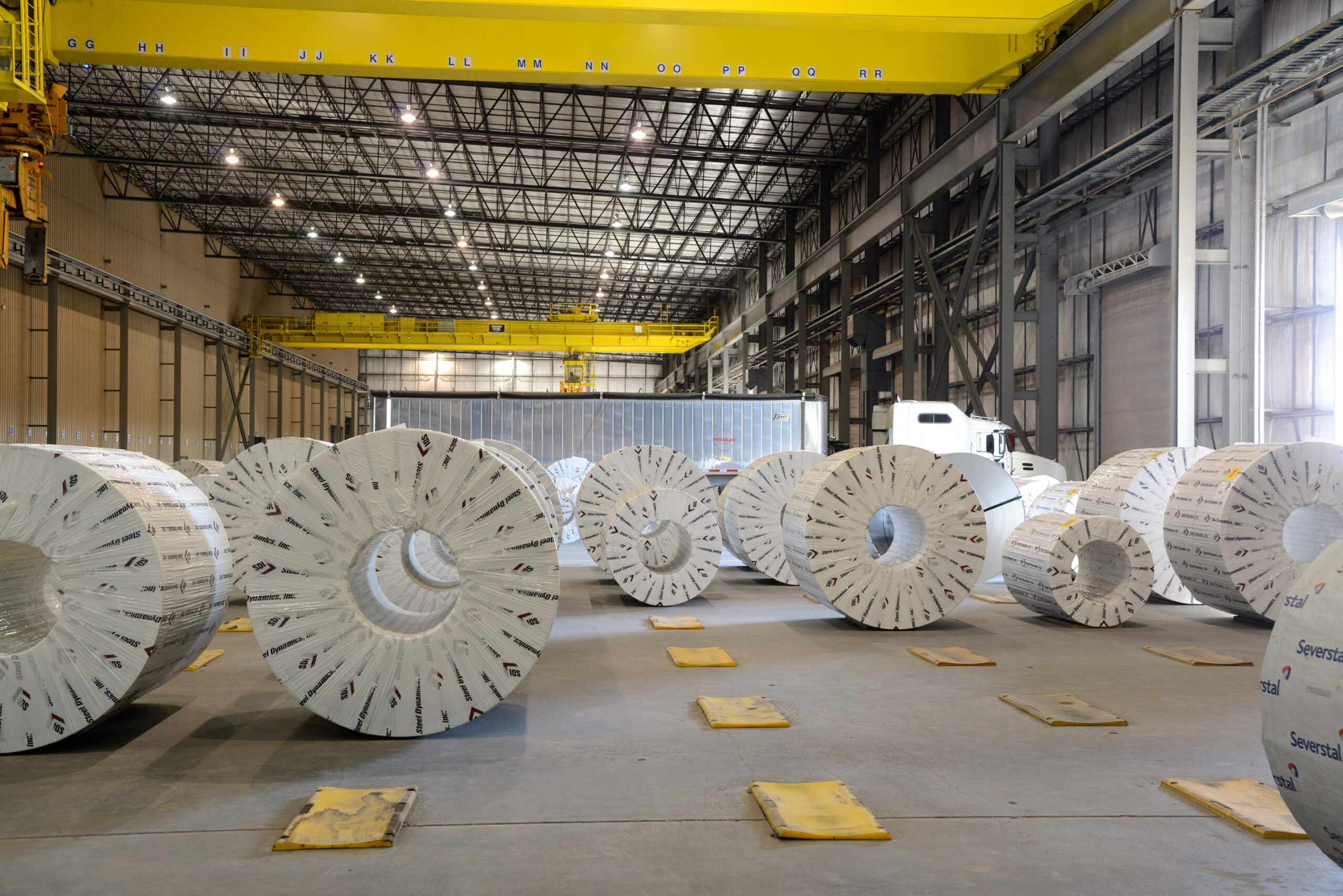FORT WAYNE, IND. (By Steel Dynamics, 21.Jul.2025, Words: 1,521) — Steel Dynamics, Inc. reported second quarter 2025 net sales of $4.6 billion and net income of $299 million, or $2.01 per diluted share. Comparatively, the company’s sequential first quarter 2025 net income was $217 million, or $1.44 per diluted share and prior year second quarter net income was $428 million, or $2.72 per diluted share.
“During the second quarter 2025, steel pricing stabilized at higher levels, resulting in a significant sequential improvement in consolidated operating income of 39 percent and adjusted EBITDA of 19 percent,” said Mark D. Millett, Chairman and Chief Executive Officer.
“The earnings improvement was driven by expanded margins across our steel platform and stronger shipments from our long products steel operations. Our three-year after-tax return-on-invested capital of 17 percent is a testament to our ongoing high-return capital allocation strategy. Across the company, our teams delivered a solid performance in an uncertain trade environment while continuing to prioritize the safety and well-being of one another,” Millett said.
“The uncertainty regarding trade policy continues to cause hesitancy in customer order patterns across our businesses, despite healthy underlying demand factors, such as manufacturing onshoring, infrastructure program funding, and increased regionalization of supply chains in the U.S.,” continued Millett. “This hesitancy, combined with an inventory overhang of coated flat rolled steel, resulted in lower steel and steel fabrication shipments in the second quarter 2025. We strongly believe that as individual country trade agreements are negotiated and trade policy is generally stabilized in the coming months, strong pent up demand for our products will result. Coupled with our expansion in value-added steel and now aluminum flat rolled products, we are firmly positioned for continued growth and long-term value creation.”
Second Quarter 2025 Comments
Second quarter 2025 operating income for the company’s steel operations was $382 million, or 66 percent higher than sequential first quarter results, due to metal spread expansion across the platform as average realized selling values increased significantly more than scrap raw material costs.
The second quarter 2025 average external product selling price for the company’s steel operations increased $136 sequentially to $1,134 per ton. The average ferrous scrap cost per ton melted at the company’s steel mills increased $22 sequentially to $408 per ton. Flat rolled steel pricing rebounded in March and continued to improve from the lower values experienced at the beginning of the year and has since stabilized at higher levels. Additionally, long product steel pricing also improved during this timeframe, and has increased further in July. The energy, non-residential construction, automotive, and industrial sectors led steel demand in the quarter.
The company’s Sinton, Texas Flat Roll Division achieved higher sequential earnings in the second quarter, despite operating at a lower production rate, due primarily to a supplier limitation. Sinton’s access to oxygen required for production was limited by its supplier for over 65 days, negatively impacting volume by an estimated 55,000 tons in the second quarter. Full access to the required oxygen has been restored.
Ongoing initiatives focused on value-added product quality and cost efficiency continue to gain traction at Sinton, providing a clear path to significantly higher profitability in the second half of the year. Second quarter 2025 earnings from the company’s steel operations were also reduced by $32 million due to a noncash write-off of consumable assets.
Second quarter 2025 operating income from the company’s metals recycling operations was $21 million, or $4 million lower than sequential earnings, based on lower realized ferrous scrap pricing more than offsetting record quarterly shipments.
The company’s steel fabrication operations generated operating income of $93 million in the second quarter 2025, lower than sequential first quarter results of $117 million, due to metal spread compression as steel raw material costs increased and the average realized sales price modestly declined. Order activity remained solid in the quarter, with the order backlog increasing 15 percent since the beginning of the year and now extends into 2026, supported by stable pricing. Demand was largely driven by the commercial, data center, manufacturing, warehouse, and healthcare sectors.
Looking ahead, the pace of domestic manufacturing investment, increased domestic onshoring activity, and momentum from the U.S. infrastructure program are expected to further support demand — not only for steel joist and deck products, but also for flat rolled and long product steel. Based on the current market environment, the company believes profitability from its steel fabrication operations reached an inflection point in the second quarter 2025, with expectations for improvement in the sequential third quarter.
Based on the company’s differentiated business model and highly variable cost structure, the company generated cash flow from operations of $302 million during the quarter. The company also invested $288 million in capital investments, repaid $400 million of its senior notes, paid cash dividends of $75 million, and repurchased $200 million of its outstanding common stock, representing 1.1 percent of its outstanding shares, while maintaining liquidity of $1.9 billion as of June 30, 2025.
Year-to-Date June 30, 2025 Comparison
For the six months ended June 30, 2025, net income was $516 million, or $3.44 per diluted share, with net sales of $8.9 billion, as compared to net income of $1.0 billion, or $6.39 per diluted share, with net sales of $9.3 billion for the same period in 2024.
First half 2025 net sales decreased four percent to $8.9 billion and operating income declined 50 percent to $658 million, when compared to the same period in 2024. Decreased earnings were primarily the result of lower realized pricing in the company’s steel and steel fabrication operations during the period. First half 2025 operating income from the company’s steel operations was $612 million, compared to $1.1 billion for the same prior year period. The average first half 2025 external selling price for the company’s steel operations decreased $105 per ton to $1,064 per ton compared to the same prior year period, and the average ferrous scrap cost per ton melted at the company’s steel mills decreased $6 per ton to $397 per ton. First half 2025 operating income from the company’s steel fabrication operations was $210 million, compared to $359 million in the same prior year period.
Based on the company’s differentiated business model and highly variable cost structure, the company achieved cash flow from operations of $454 million in the first half 2025. The company also invested $594 million in capital investments, repaid $400 million of its senior notes, paid cash dividends of $144 million, and repurchased $450 million of its outstanding common stock, representing 2.4 percent of its outstanding shares, while maintaining liquidity of $1.9 billion.
Outlook
“We remain confident that market factors are in place to support strong domestic steel and aluminum product consumption in the coming years, as the uncertainty concerning trade and tax policies is mitigated and the interest rate environment improves,” continued Millett. “Additionally, based on conversations with our customer base, we believe demand for lower-carbon-emission, domestically produced steel and aluminum products will competitively advantage our businesses now and in the future. As unfairly traded imports decline, uncertainty dissipates, and growth of manufacturing continues to increase in the U.S., we believe a strong market environment will emerge, supporting pricing and demand.
“Additionally, we view the U.S. International Trade Commission’s preliminary determinations on coated flat rolled steel as a significant positive development. A reduction in unfairly traded imports of these products would be a meaningful tailwind for us, as we are the largest non-automotive flat rolled steel coater in the United States. We expect to receive final determinations before the end of the third quarter 2025. Taken together, these broader market dynamics are expected to positively impact all of our operating platforms.
“Our aluminum team continues to successfully commission the company’s Columbus, Mississippi aluminum flat rolled products mill, along with the San Luis Potosi, Mexico satellite recycled slab center. Last month we successfully produced and sold our first aluminum coils, and we expect volume to steadily increase over the coming months. We anticipate exiting 2025 at a utilization rate of between 40 and 50 percent, and 2026 at an exit rate of 75 percent, as product certifications occur.
“We have intentionally aligned our growth with the evolving needs of our customers by delivering efficient, sustainable supply chain solutions alongside the highest quality products. To date, this strategy has been focused primarily on the steel industry. However, many of our flat rolled steel customers are also significant consumers and processors of aluminum flat rolled products. We are excited to expand and diversify our end markets by supplying aluminum flat rolled products with high recycled content—serving the counter-cyclical, sustainability-driven beverage can and packaging industry, as well as the automotive, industrial, and construction sectors. Our proven, performance-based operating culture—combined with deep expertise in building and running cost-effective, highly profitable flat rolled steel mills—positions us exceptionally well to execute on this strategic initiative. We believe this expansion represents a compelling opportunity for long-term value creation, and both our customers and our teams are energized by the potential it brings.
“We remain firmly committed to the health and safety of our teams, their families, and the communities we serve, while meeting the evolving needs of our customers. Our culture and performance-driven business model continue to positively differentiate our company. We remain focused on delivering superior value to our team members, customers, and shareholders,” concluded Millett.
____________________


